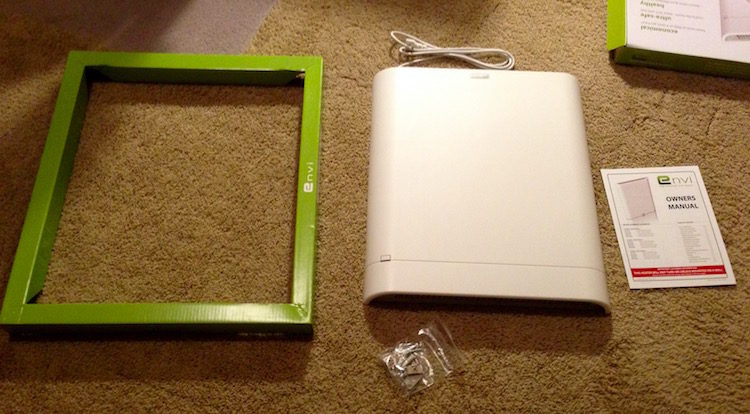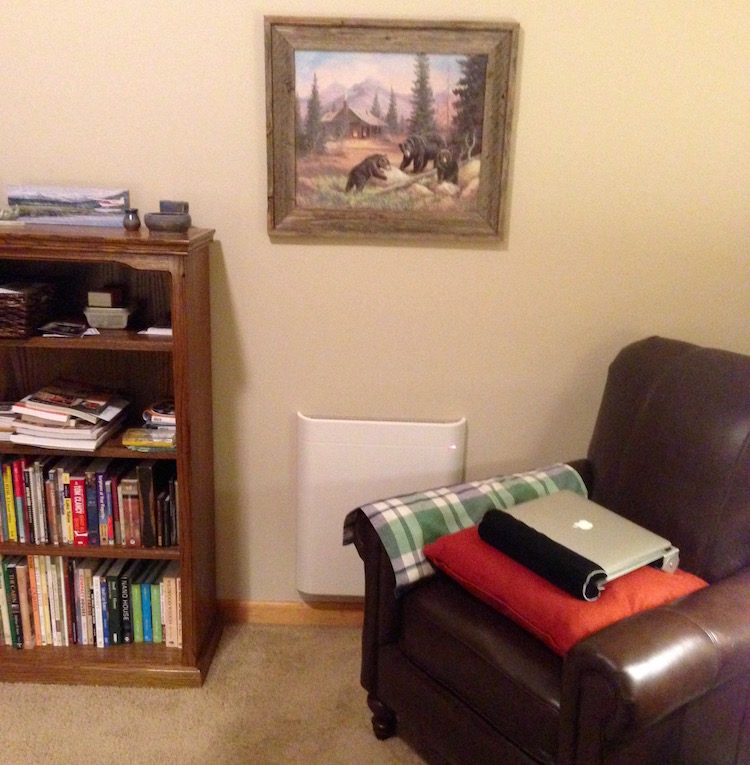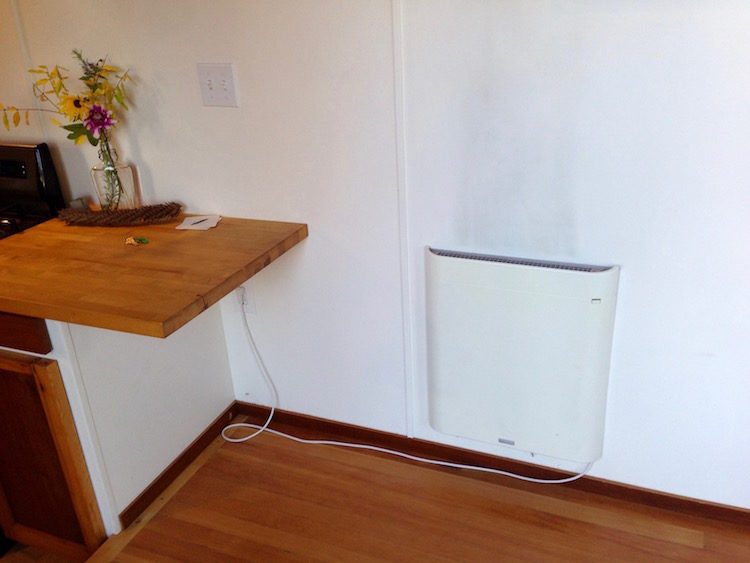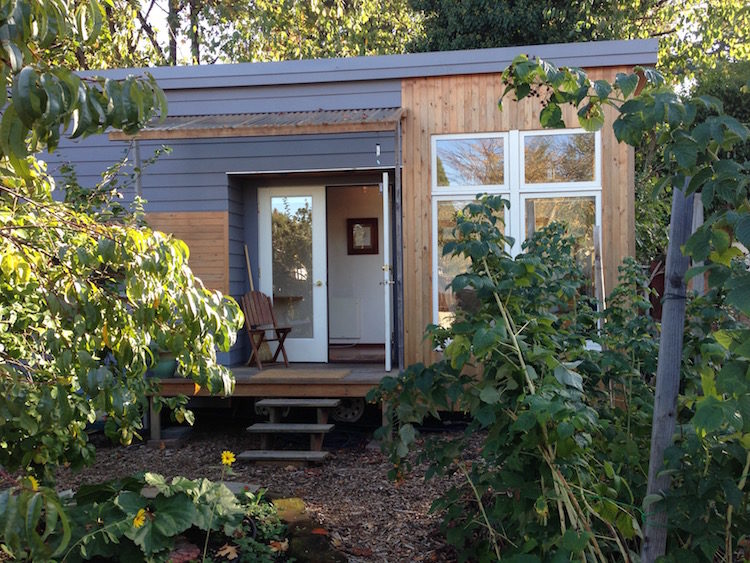I’ve been using a Envi Heater to supplement or replace the heat in my spare bedroom office for the last month or so. I usually am up before everyone else in the “big house” and don’t turn up the heat in the morning. I turn this slim, quiet, little wall heater on and it soon has my 10×10 office quite comfortable. Even when we have been down in the single digits it seems to do its job in keeping me warm.

One of the neat things about this little heater is that it is so easy to install. It comes with a template to set up where you need to put the clips to hold it to the wall. I put this up in less than 10 minutes and it feels solid and I don’t have to worry about it falling off the wall and burning anything. It is quiet unlike many electric heaters. I never hear it but only feel its heat.

I recently was visiting a tiny house in Portland, Oregon and the owner said that they use it as the main heating source for the tiny house. Portland is more mild than here in Bend so in most cases it fulfills its duty. She said when it is extremely cold that they pull out an additional radiant heater and between the two of them it is always toasty.

So if you are living on the grid and have electricity and are looking at heater options I would suggest you check out the Envi heater. It is affordable and attractive and easy to install.
You can learn more at their website if you are interested: http://www.eheat.com/


I also use the Envi heater as my main source of heat here in Southern Ontario. I live in a 14ft reno’d travel trailer and although our weather has not really been very cold yet, nor has it been steadily cold, I have so far found it to be sufficient. I also have a dehumidifier running which seems to help as well. I have not generally had to turn the heater to it’s highest heat generally either and it seems to be keeping the temps around 20C, which is pretty comfortable, when sitting I usually wear a sweater. I am crossing my fingers that the Envi will be able to keep me warm when the temps drop to the customary temperature. Bear in mind I only have 2″ rigid foam insulation in the walls and I didn’t re-
insulate the floors, although I have skirted most of the trailer, one side still needs to be done. So at this point I am happy with my Envi as well.
This seems more practical and safe than a space-consuming wood stove.
Wood stoves also create a large amount of sticky dust that may cause asthma.
These could be installed anywhere, such a ceiling in a loft or kitchen as well as a wall in a bathroom or living area.
Two or three units in different areas would be toasty.
They only have a two-inch depth, which is a lot less than most heaters and certainly a lot less work and cleanup than a woodstove.
This looks like a good replacement for my oil filled portable electric radiator. Saves a lot of inches being wall mounted like that.
Looks great, but I wonder how much electricity it consumes. It could be a costly solution if it’s a power-hog.
So far just a trickle that I can tell and as they advertise.
It runs at full at 450W, less then half of what a traditional oil filled heater or most electric space heaters run at.
After finding some Heater Specs on ‘Lowe’s’ Website, I ran some numbers in hopes of helping Folks make a BTU-based decision that keeps them warm.
The Envi Heater draws 3.3 Amps @ 120 Volts to produce 1,352 BTU. Many conventional Portable Heaters consume ~12.5 Amps @ 120 Volts to produce ~5,200 BTUs. Either these, or the nicely-designed Envi, produce around 410 BTUs/Amp consumed. FYI, most Wall Outlets are Breakered at 15 Amps. Some at 20 Amps. This is one reason why so many conventional Portable Heaters are designed to draw 12.5 Amps: to not trip 15 Amp Circuit Breakers.
So, it all comes down to whether the Envi’s BTU Output will do the Job in the desired Environment, and Square Footage. For the small ~120 SF to ~200 SF area this Heater is spec’ed for – or, for larger, well-Insulated areas – Testimonials indicate it works well. The Form Factor, and quiet operation, is nice. Note some Wall discoloration in one Picture above.
It would take 4 ~$99- Envis to create about the same BTUs of Heat as 1 – 13 Amp – ~5,200 BTU, ~$40- Portable Heater w/Fan. Fans are required in ~5,200 BTU Portable Heaters to transfer higher Heat Loads away. Fans are not required in 1,352 BTU Envis. Fans of some type help move warm, stratified Air from Ceilings [or Lofts].
As I’ve seen in Japan, Room-by-Room ‘Demand’ Heating – that multiple Envis would permit – is a nice, Electricity-saving way to go.
Hi Rebecca:
I would like to be able to answer you, but cannot. That said, you and I highlight a gaping hole in TH enthusiasts knowledge of solar electricity, the mechanics, how to assess output, 12V versus 120V, what does this mean in terms of whether a panel or panels generates enough electricity for a laptop, lights, and heat. I would love if there is a relatively simple formula for determining what I need given a set of electrical needs??? How can I comprehend and assess? Anyone?
Can you run it off solar panels?
Awesome! Looking to use one of these for a small to the medium-sized bedroom. It used to have 220 baseboard heat, as does the rest of the home as it’s an early 90’s house in the northeast US so that’s not uncommon. Well, the heater in the bedroom has been kaput for years, and I’ve been using an oil-filled radiator space heater in it. Well, I want something more permanent so I’ll install one of these because I’ve since covered up the baseboard with furniture and don’t want to rearrange the room. There is a version of this heater that runs on 220v and doesn’t have the built-in thermostat so I can install a Mysa Smart Thermostat (one of the only and probably the best smart thermostats for line voltage electric heat, Nest and Ecobee, etc are for low-voltage applications and relay driven systems only) and the rest of the house has Mysis and then I control it centrally remotely or with some Google Homes, etc.